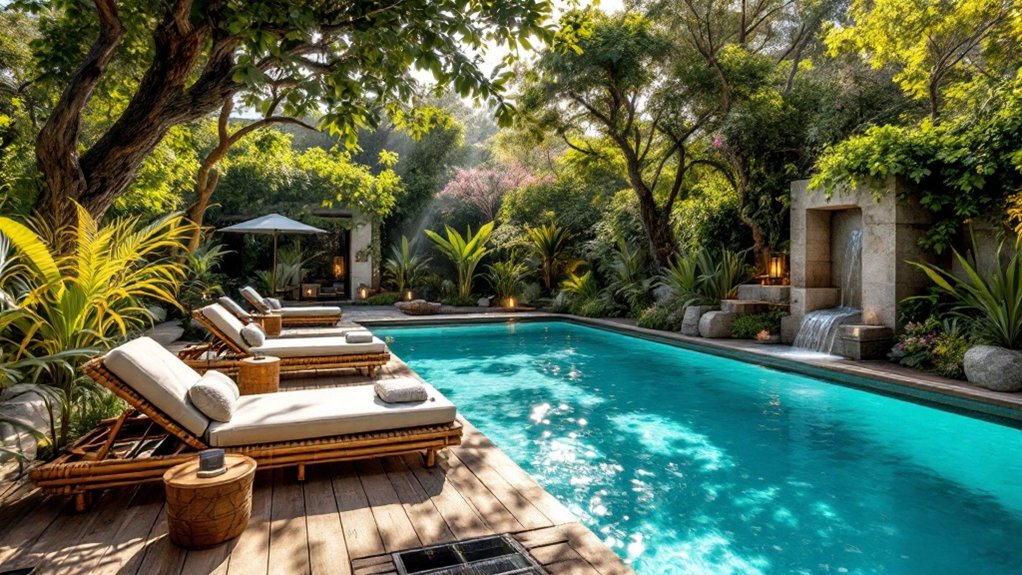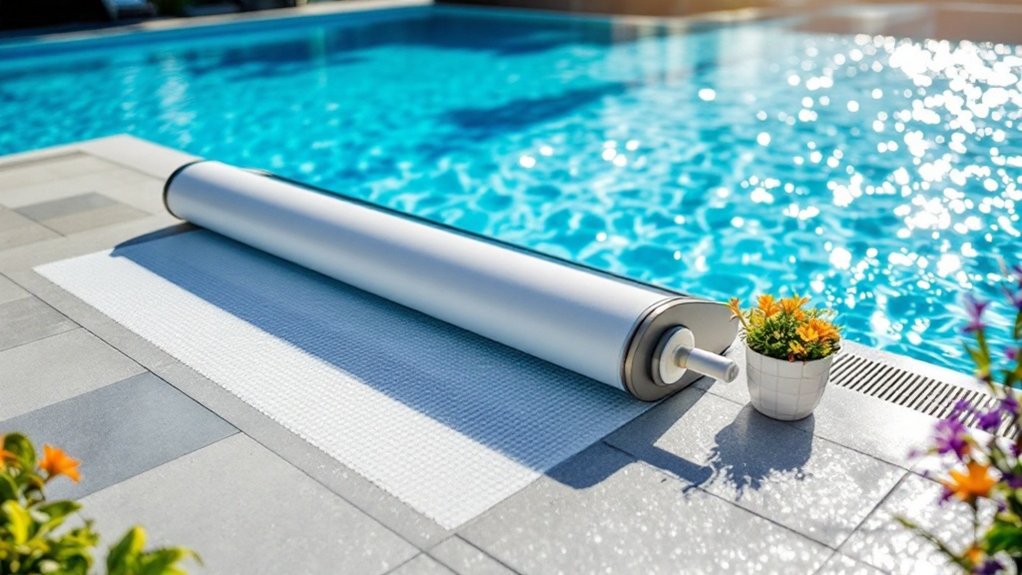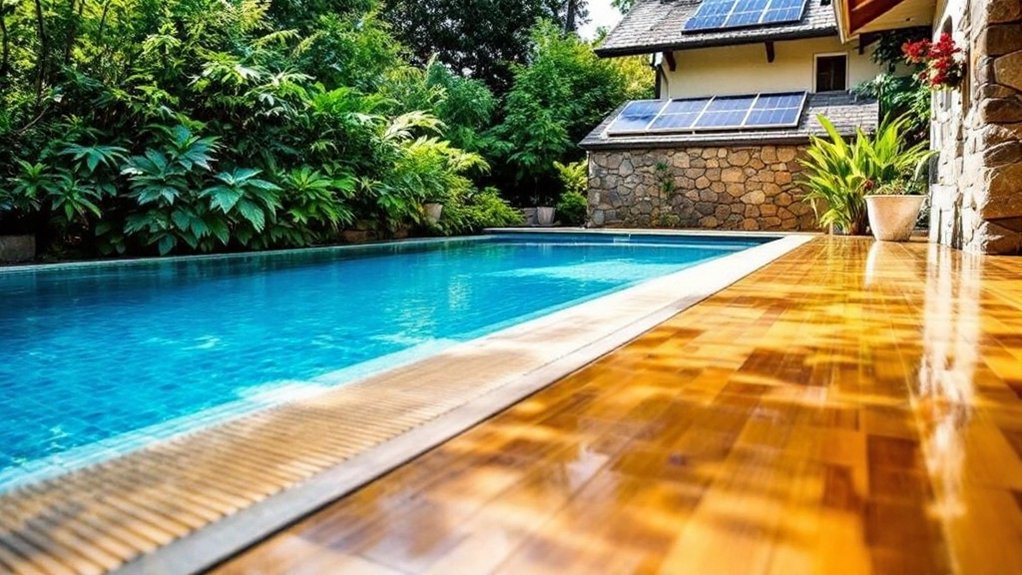Creating an eco-friendly poolside landscape is a thoughtful endeavor that combines beauty and sustainability. By selecting native plants, homeowners can enjoy low maintenance while supporting local wildlife. Additionally, incorporating water-saving features not only conserves resources but also enhances the overall design. Sustainable materials play a vital role in both aesthetics and durability. There are numerous strategies to contemplate, each offering unique benefits for an outdoor oasis. What might those strategies look like?
Embrace Native Plants for Low Maintenance Beauty
When designing a poolside landscape, embracing native plants can greatly enhance beauty while minimizing maintenance. Native plants are well-adapted to the local climate, requiring less water and fewer fertilizers than non-native species. Their resilience against local pests and diseases means that they often thrive without extensive care. By incorporating a variety of textures and colors, native plants can create a visually appealing environment that complements the pool area. Additionally, they support local wildlife, such as pollinators and birds, contributing to biodiversity. When choosing native plants, homeowners can select species that bloom at different times throughout the year, ensuring year-round interest. Overall, native plants offer a sustainable approach to poolside landscaping that prioritizes both aesthetics and ecological health.
Incorporate Water-Saving Features
Although traditional landscaping often requires significant water usage, incorporating water-saving features into poolside designs can create a more sustainable environment. Utilizing drip irrigation systems is one effective method, as they deliver water directly to plant roots, minimizing evaporation. Rainwater harvesting systems can also be integrated, capturing and storing rain for irrigation purposes, thereby reducing reliance on municipal water supplies. Additionally, installing permeable paving around the pool allows rainwater to filter through, replenishing groundwater while preventing runoff. The use of drought-resistant plants further enhances this eco-friendly approach, ensuring that the landscape remains vibrant without excessive watering. By embracing these water-saving features, poolside landscapes become not only beautiful but also environmentally responsible, contributing to water conservation efforts.
Design With Sustainable Materials
Incorporating sustainable materials into poolside landscaping enhances both aesthetics and environmental responsibility. Natural stone, reclaimed wood, and eco-friendly composites serve as excellent choices for creating a visually appealing environment. These materials not only reduce the carbon footprint but also promote durability and longevity. For instance, using permeable pavers can facilitate efficient water drainage, minimizing runoff and erosion. Additionally, incorporating recycled glass or metal accents can add unique design elements while supporting sustainable practices. Native plants, when combined with these materials, can further enhance the landscape, providing habitat for local wildlife. By thoughtfully selecting sustainable materials, property owners can create an inviting poolside retreat that harmonizes with nature while exemplifying a commitment to eco-friendly living.
Create Shade With Eco-Friendly Structures
Creating shade with eco-friendly structures not only enhances comfort by protecting poolside areas from the sun but also contributes to sustainable landscaping practices. Incorporating elements such as pergolas made from reclaimed wood or bamboo can provide aesthetic appeal while minimizing environmental impact. Green roofs and living walls are also excellent options, promoting biodiversity and natural cooling. Shade sails crafted from recycled materials offer a flexible and visually striking solution, adapting to various poolside configurations. Additionally, strategically planted trees can create natural shade, reducing the need for artificial structures and promoting a healthier ecosystem. By integrating these eco-friendly options, homeowners can achieve a comfortable, shaded environment that aligns with their commitment to sustainability.
Enhance Your Space With Natural Hardscaping
While traditional hardscaping often relies on synthetic materials, enhancing a poolside space with natural hardscaping can greatly elevate its aesthetic and environmental value. Utilizing materials such as stone, wood, and gravel not only provides a rustic charm but also integrates seamlessly with the surrounding landscape. For instance, natural stone patios can create an organic feel, while wooden decks offer warmth and texture. Additionally, permeable pavers allow for better drainage, reducing runoff and promoting eco-friendliness. Incorporating features like boulders or dry riverbeds can also enhance visual interest while supporting local flora and fauna. By choosing natural hardscaping elements, homeowners can cultivate a serene poolside retreat that harmonizes with nature, fostering sustainability and beauty in their outdoor spaces.
Frequently Asked Questions
How Can I Keep My Pool Area Mosquito-Free Naturally?
To keep a pool area mosquito-free naturally, one can plant mosquito-repelling herbs like lavender and citronella, utilize essential oils, maintain proper drainage, and encourage natural predators such as bats and birds to inhabit the space.
What Are the Benefits of Using Solar Pool Heaters?
The benefits of using solar pool heaters include reduced energy costs, environmental sustainability, extended swimming seasons, and minimal maintenance. These heaters harness sunlight, converting it into energy, providing an eco-friendly solution for pool temperature regulation.
Can I Use Recycled Materials for Poolside Furniture?
Recycled materials can certainly be utilized for poolside furniture. This choice not only promotes sustainability but also adds unique character to outdoor spaces, providing durability and creativity while reducing environmental impact through innovative design and resourcefulness.
How Do I Maintain My Eco-Friendly Landscape During Winter?
To maintain an eco-friendly landscape during winter, one should guarantee proper mulching, protect sensitive plants, reduce water usage, and consider seasonal planting. Regular inspections for pests and debris will also help sustain the landscape’s health.
Are There Any Eco-Friendly Pool Cleaning Options Available?
Various eco-friendly pool cleaning options exist, including solar-powered robotic cleaners, natural enzyme-based treatments, and biodegradable chemicals. These alternatives minimize environmental impact while effectively maintaining pool cleanliness, promoting a sustainable approach to pool care and upkeep.
Conclusion
Transforming a poolside into an eco-friendly oasis is not only feasible but also rewarding. By embracing native plants, incorporating water-saving features, and utilizing sustainable materials, homeowners can create a beautiful and low-maintenance landscape. The addition of shade structures and natural hardscaping elements further enhances the aesthetic appeal while supporting local wildlife. Ultimately, these thoughtful design choices contribute to a stunning outdoor space that is both environmentally friendly and inviting for relaxation and enjoyment.




